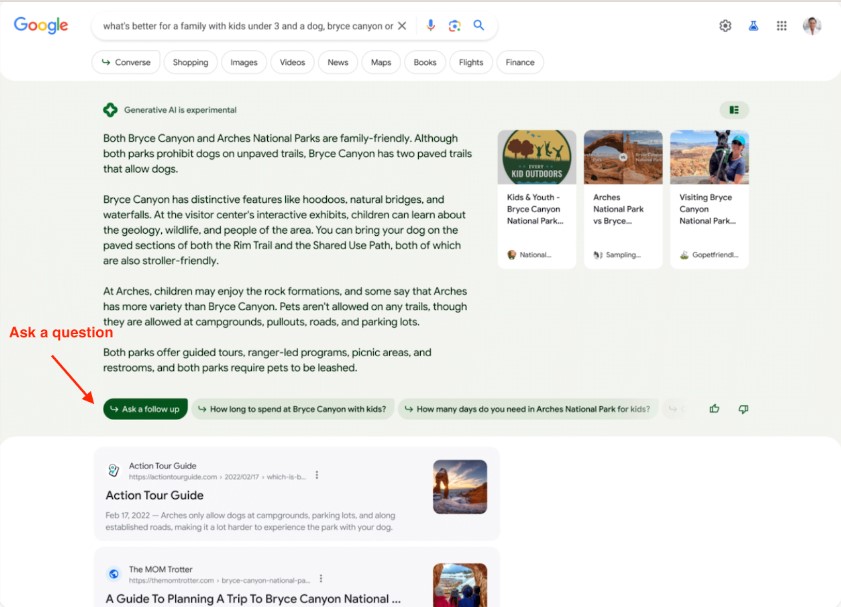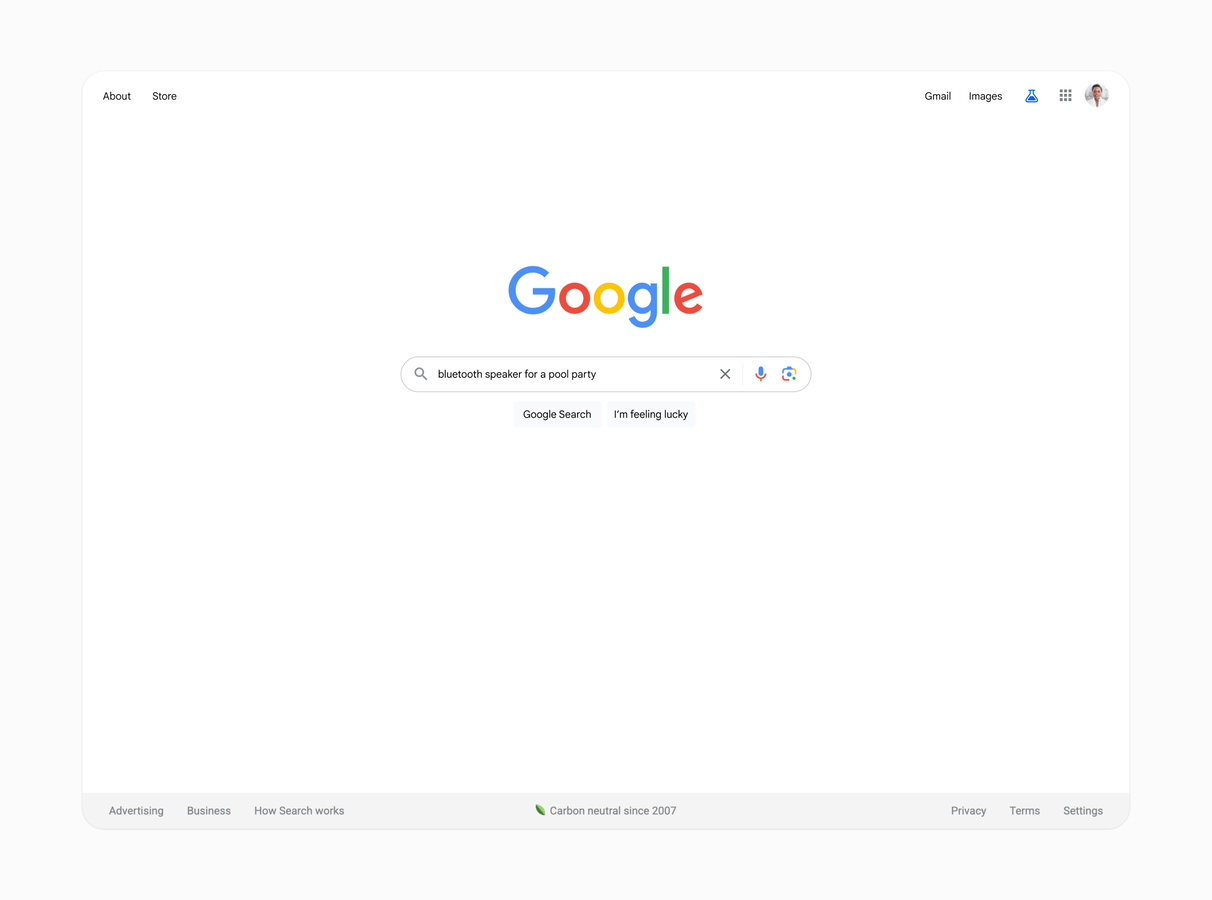
Google reveals plans for AI integration in search
On Wednesday 10th May 2023, Google held its annual developer conference in the US Google.io and there were a number of new initiatives and exciting announcements. Here, we’ll share what these were, what they mean for search, and how we are thinking about them going forward.

It’s clear that AI will be at the heart of every Google product from this point on. Wider announcements at the event included changes to products such as Google Maps, which now offers an "Immersive View for Routes" feature in select cities, which brings together updates such as traffic simulations, bike lanes, complex intersections, parking, and more, in one place.
There’s a great summary of the whole event in under 10 minutes here and a more detailed publication from Google on the changes here.
The key announcements from our search perspective
Google has launched its newest large language model, called PaLM 2. This will power the updated Bard chat tool (Google's ChatGPT equivalent), which means you can ask it even more complex questions and get more accurate results.
Access to Bard has been expanded and is now available in 180+ countries and languages – available here: https://bard.google.com/
Google is testing a new search generative experience (SGE) with AI capabilities that make searching more natural and intuitive.
Here’s what the new search experience with generative AI will look like
Google shared an example response to the question: “what's better for a family with kids under 3 and a dog, bryce canyon or arches.”
There are two elements to the result.
1) AI-powered snapshots. These help people quickly get an overview, with factors to consider: "These snapshots serve as a jumping-off point from which people can explore a wide range of content and perspectives." They appear to be an advanced visualisation of the current featured snippets.
The response itself provides a snapshot of key information to consider, with links to publishers’ websites so users can dig deeper.
2) Conversational mode. “Ask entirely new types of questions that you never thought Search could answer”. This is a significant change in behaviour.
There will be suggested next steps below this response, including the ability to ask follow-up questions, which will enable a conversational dialogue to take place (similar to how the Chat GPT and Bard experience works currently).

When shopping for a product, the AI response will also highlight factors to consider and products that fit the intent built upon their existing Shopping Graph. The user will also see product descriptions that include relevant, up-to-date reviews, ratings, prices, product images and links to products.

Key takeaways
The response appears to be triggered by informational and conversational queries, with the latter being a change in user behaviour that Google is hoping will emerge from this integration.
The response will appear above the current search results and will likely replace featured snippets but, below this, the 10 blue links remain, giving the user the option to continue using search as they have done previously.
On the right-hand side of the response, Google cites the websites it used to generate the answer, which will enable users to dig deeper. These are prominently displayed in the answer with a thumbnail image, title, and URL – all that is clickable to the publisher’s website. A route to drive clicks is very welcome.
The colour of the generative AI answer box will change to “reflect specific journey types and the query intent itself,” Google said.
Paid ads will be integrated into dedicated ad slots throughout the page. When Search ads do appear, they will continue to feature industry-leading clear and transparent ad labels with the “Sponsored” label in bold black text.
Google has deployed its search quality raters to do some early testing over the next few weeks before launching it to the first set of public users. You can sign up for testing if you are in the US in Google Search Labs.
Where Google won’t give answers
Google is trying to be careful with this new version of Google Search, which will show answers for safer queries.
“Just as our ranking systems are designed not to unexpectedly shock or offend people with potentially harmful, hateful, or explicit content, SGE is designed not to show such content in its responses,” Google explained.
Google won’t give you answers for everything you might ask it. The AI only appears when the algorithm thinks it's more useful than standard results. For example, Google won’t show an answer to a question about giving a child Tylenol because it is in the medical space.
Google may also not show answers to questions in the financial space and other Your Money, Your Life categories, such as health.
Where Google’s systems have lower confidence in its responses, Google “aims to not generate an AI-powered snapshot,” they said. They are concerned about AI making up responses (hallucinations) in these cases.
For explicit or dangerous topics, such as self harm, Google will stay away from generating a response.
How we’re thinking about this change at Reddico
Whilst it’s an exciting announcement, there’s no current timeline for when this will be fully operational for all users. This feature is entering the first public testing phase and we have seen previous testing phases or new releases last months and even years.
As we gain access we will be able to test a variety of searches across a range of verticals, uncover insights, and adapt our existing strategies. Helping our clients to measure the impact of this change will be a key part of that.
We expect to see measurement tools such as Google Search Console and third-party tracking tools adapt with new features for reporting on attribution, but not until this is out in the wild and Google is confident of a broader market release.
Organic now becomes ‘everywhere’ in search and not just the 10 blue links on page 1, which creates new opportunities. However, the fundamentals of SEO still remain key to driving success and growing traffic. Google needs to be able to crawl, understand, and surface the content from a website. Links and external signals will still help Google decide which sources to trust and use as part of their response. Building authority remains a key part of winning in this new search landscape.
From a content perspective, there is now a greater emphasis on high-quality content that shows expertise, authority, trust and, importantly, experience, both in terms of Google using those as sources to generate an AI answer and displaying it in the result, and the website ranking in traditional search. There will also be opportunities to target traditionally commercial searches with informational content in a way we haven’t been able to do before, which is an exciting development.
Google highlighted the importance of experience in a separate announcement that went under the radar:
“In addition to making it easier to find authentic perspectives, we're also improving how we rank results in Search overall, with a greater focus on content with unique expertise and experience. Last year, we launched the helpful content system to show more content made for people, and less content made to attract clicks. In the coming months, we’ll roll out an update to this system that more deeply understands content created from a personal or expert point of view, allowing us to rank more of this useful information on Search.”
What should we be thinking about in the coming months?
The key point here is that this is still part of Google Labs, and is entering the testing phase and gathering feedback from users. Google will continue to incentivise websites to create content and reward great content, as it’s essential to a healthy ecosystem on which the AI will rely on.
It’s positive to see Google reference sources used to generate the AI response and provide direct links to websites in order to drive clicks to publishers (this wasn’t the case with Bard). But the key will be how users take to it; this still requires a change in user behaviour to make it work. We expect further changes, tests, and tweaks.
Whilst testing begins, there are a couple of areas to focus on
Use this as an opportunity to help prioritise key technical changes and improvements within your business to help Google better discover, understand, and reward pages. Easy discoverability for Google is the first step to surfacing great content.
Use this as an opportunity to push through and prioritise any content changes to focus on Experience, Expertise, Authoritativeness and Trust (EEAT) signals (including authors, sitewide trust signals, and building experience into existing content pieces). Google is looking to surface content from trusted and experienced authors.
Reddico currently tracks all the SEO data points we can within the search results to ensure we can measure any future impact. However, there is an opportunity to revisit keyword tracking for informational keywords and the informational content strategy. We need to be aware that informational content that presents facts without experience and experience is at risk here.
For shopping queries and e-commerce sites, there is an opportunity to revisit and improve organic shopping feeds and the information stored within the Shopping Graph.
New opportunities will emerge from this, as they always do as Search evolves. These should benefit businesses and website owners by driving more engaged traffic to their sites.
It's important to note that while Reddico is considering these changes from an organic perspective, they will affect all areas, including PPC, display, direct, affiliate, and referral.
All our SEO team are here and available to answer questions you may have. Please feel free to contact us.
Additional reads:
https://searchengineland.com/sign-up-new-google-search-generative-experience-413639
https://www.seroundtable.com/google-search-generative-experience-ai-35360.html
https://www.theverge.com/2023/5/10/23717120/google-search-ai-results-generated-experience-io
https://blog.google/technology/developers/google-io-2023-100-announcements/
Sign-up to Reddico News
To keep up-to-date with the latest developments in the world of SEO, our insights, industry case studies and company news, sign-up here.




